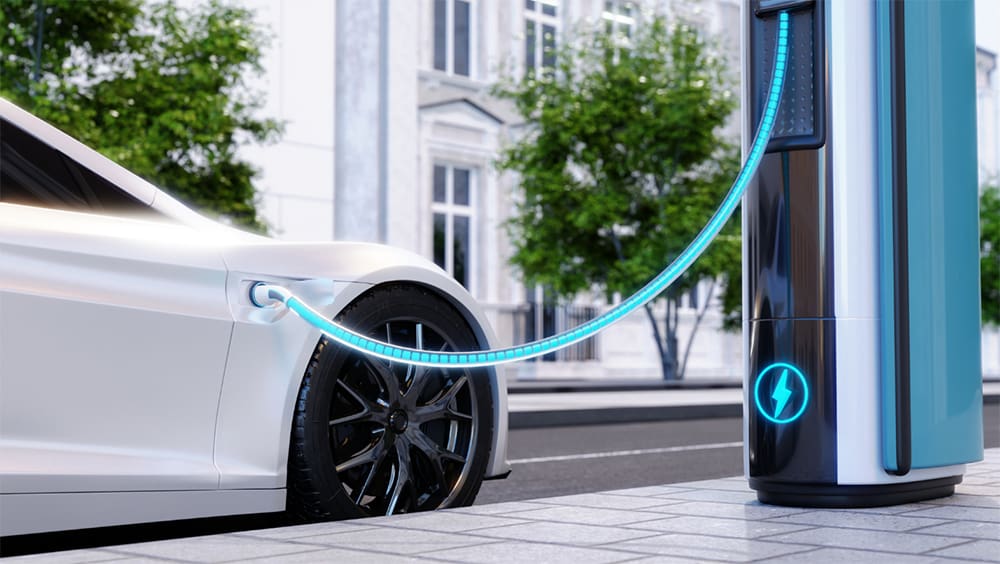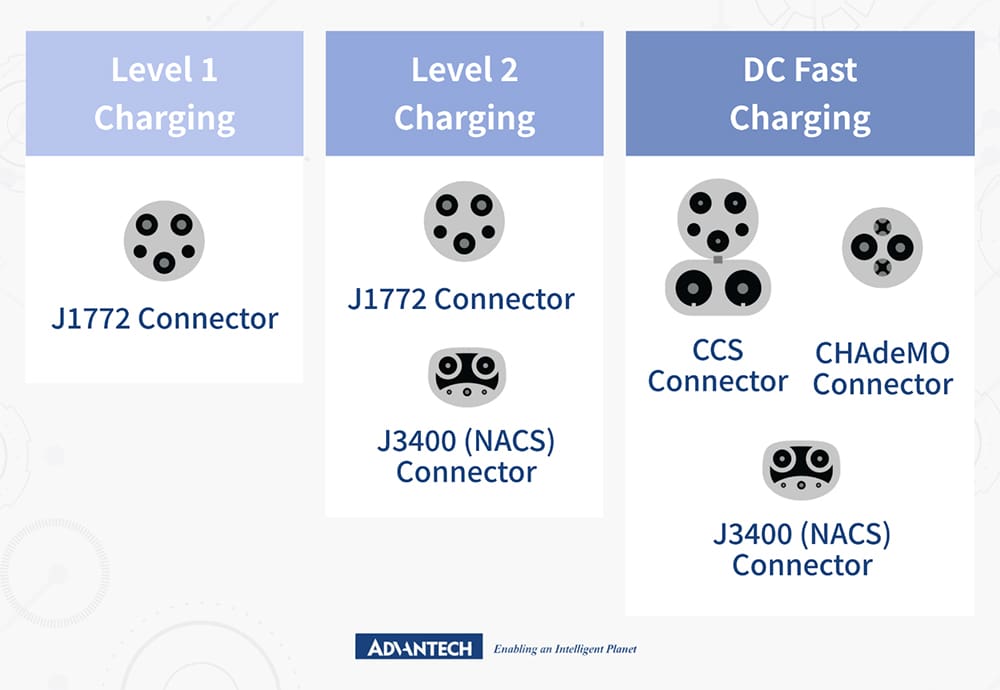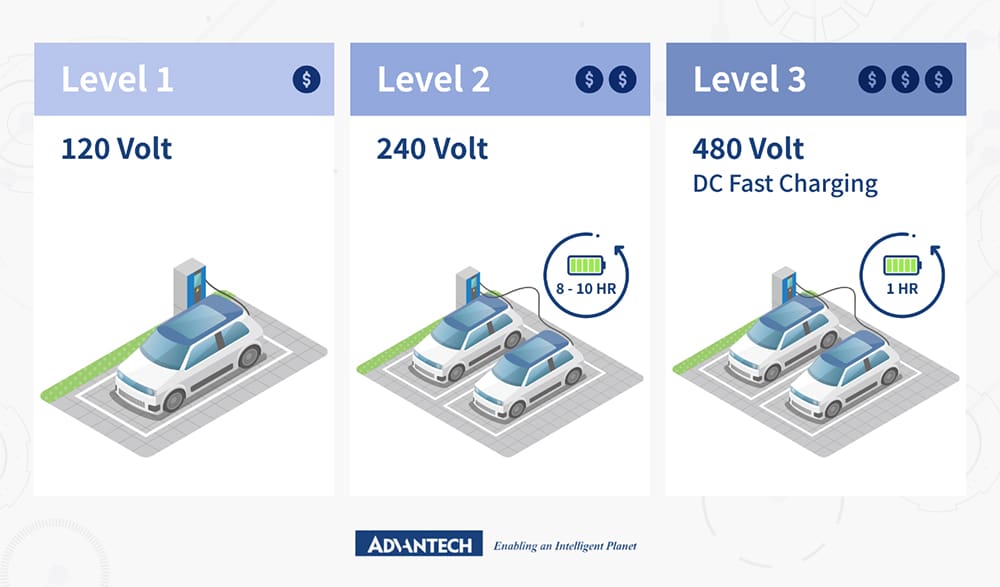

What is EVSE: Meaning
Electric Vehicle Supply Equipment (EVSE) refers to the infrastructure and components essential for charging electric vehicles (EVs). Often known as charging stations, charging docks, or simply chargers, EVSE provides power supplies to recharge electric vehicle batteries. This comprehensive system includes charging stations, connectors, cables, and control systems, all meticulously designed to deliver electricity safely and efficiently to EVs.
What are the Components of EV Supply Equipment?
From housings to connectors, let’s look at the essential elements that power EVSE.
Housing/Enclosure
EVSE housings are designed in various configurations to meet diverse charging needs. Standalone boxes are commonly employed for home charging setups, offering a compact and user-friendly solution. Wall or pedestal-mounted enclosures provide flexibility for multi-family residential, workplace, and other public charging environments, ensuring accessibility and convenience. Towers, prevalent at public charging stations or commercial fleet depot locations, consolidate multiple charging points into a single structure, optimizing space and resources. These enclosures are typically constructed using durable materials such as weather-resistant plastics or metals, safeguarding essential EVSE components from environmental elements.
Firmware
The firmware embedded within EVSE components serves as the brains behind the charging operation, enabling advanced functionalities and ensuring compatibility with a wide range of electric vehicles. This microcode governs various aspects of charging management, including initiating and terminating charging sessions, implementing cybersecurity measures to protect against unauthorized access or tampering, and facilitating communication between the EVSE and the vehicle’s onboard systems.
Connector/Plug
EVSE connectors play a crucial role in facilitating the transfer of electrical power between the charging station and the electric vehicle. Different connector types are used for various charging levels and charging standards, ensuring compatibility and interoperability across different EV models and charging infrastructure.
Common connector standards include J1772 for Level 1 and Level 2 charging, offering widespread compatibility across EV models. The CCS connector supports AC Level 1 and Level 2, as well as Level 3 DC fast charging, with additional pins for enhanced functionality. CHAdeMO is predominantly used by Japanese manufacturers for DC fast charging applications. The NACS (J3400) connector enables Level 2 and Level 3 charging, allowing non-Tesla EV charging at Tesla stations equipped with this standardized connector type.
These connectors feature robust construction and standardized pin configurations to ensure secure and efficient power transmission during charging sessions. By supporting multiple connector types, EVSE maximizes accessibility and convenience for EV owners, regardless of their vehicle’s make or model.

The variety of connector types in EVSE stems from vehicle manufacturers’ diverse port connections on EVs. Stations with multiple cable options are often available to accommodate various connectors. Naturally, many EV owners carry adapters on their own for charging at different stations just in case.
Electronics
The electronic components of EVSE play a critical role in managing charging sessions and ensuring efficient power delivery to electric vehicles. The main relay acts as a gateway, controlling the flow of electricity to the vehicle and safeguarding against overcharging or electrical faults. The control module orchestrates the charging process, communicating with the vehicle and monitoring battery health to optimize charging efficiency. A robust power supply ensures stable power output, while dedicated electrical circuits for each charging socket minimize the risk of circuit overload and ensure reliable performance.
Cables
Cables in EVSE serve as conduits, transmitting power from the charging station to the vehicle. They come in flexible or permanently attached options, offering maneuverability or enhanced durability. Ideally, longer cables provide greater convenience, but NEC regulations limit cable length to 25 feet. However, if equipped with a cable management system integrated into the EVSE, the cord length can exceed this limit. These regulations ensure safety and compliance with industry standards for EV charging installations.
Network Connectivity
By integrating WiFi or cellular connectivity, EVSE can communicate with mobile apps or cloud-based charging management platforms, allowing users to remotely monitor and control charging sessions from anywhere. This connectivity enables features such as scheduling charging times to take advantage of off-peak electricity rates, receiving real-time charging status updates and notifications, and accessing historical charging data for analysis and optimization. Network-connected EVSE also enables fleet operators and charging station owners to remotely manage and monitor multiple charging stations, ensuring efficient operation and maintenance.
Common Features of EVSE
EVSE comes with a range of features designed to ensure efficient and safe charging for EVs.
Firstly, EVSE often incorporates smart charging capabilities, allowing users to monitor and control the charging process remotely. Smart EVSE systems enable features such as scheduling charging times, setting charging limits, and receiving notifications on charging status via mobile apps or online platforms. This not only enhances user convenience but also enables more efficient use of electricity, particularly during off-peak hours when energy costs may be lower.
Furthermore, safety features are paramount in EVSE design. EVSE systems include built-in features, such as breakaway cables, safety outlets, thermal sensors, and ground fault circuit interrupters, to protect against overcharging, overheating, short circuits, leakage current, and other potential electrical hazards. These safety mechanisms ensure that both the EV and the charging infrastructure remain secure during the charging process.
Finally, interoperability is a key consideration in EVSE design. Compatibility with different EV models and charging standards ensures that EV owners have access to charging infrastructure regardless of their vehicle type or manufacturer. Common charging connectors, such as the SAE J1772 or CCS (Combined Charging System), allow for seamless connection between EVs and the charging stations.
Overall, the features of EVSE contribute to a user-friendly, efficient, and safe charging experience for electric vehicle owners, supporting the transition to a more sustainable transportation ecosystem.
Main Types of EVSE
According to the National Electrical Manufacturers Association (NEMA) and the US Department of Energy, EVSE is classified into three levels based on the voltage and charging capabilities:
Level 1 Charger
Level 1 chargers operate on standard 120-volt AC household outlets, making them the most accessible, budget-friendly, and convenient charging option for EV owners as they use typical household outlets. These chargers typically provide a slower charging rate compared to higher-level chargers. Charging a regular electric vehicle (EV) for 8 hours at 120 volts can add about 40 miles of electric range.
These chargers are suitable for residential charging, allowing EV owners to plug their vehicles into standard electrical outlets in garages, driveways, or parking spaces overnight. They are ideal for individuals with limited daily driving needs or those who have ample time for charging.
Level 2 Charger
Level 2 chargers operate on 240 volts AC power, offering faster-charging rates than Level 1 chargers even though they adopt the same J17772 connector. These chargers require the installation of dedicated stand-alone charging equipment. Charging an electric vehicle (EV) for 8 hours with a Level 2 charger can add more or less 200 miles of electric range for a mid-size EV.
These types of chargers are commonly installed in residential settings for faster home charging (multi-family units) or in public charging stations, workplaces, hotels, commercial buildings, and parking facilities. They are suitable for EV owners with moderate to high daily driving distances or those who require quicker charging due to their significantly reduced charging times.
Level 3 Charger
Level 3 chargers, also known as DC Fast Chargers or DCFCs, operate on high-voltage direct current (DC) power (480 volts), providing rapid charging capabilities for EVs. These chargers can deliver significantly higher charging rates compared to Level 1 and Level 2 chargers, enabling quick replenishment of EV batteries. With 30 minutes of charging using DC Fast chargers, it can add around 100 to 200 miles of electric range.
These chargers are primarily installed in public charging networks, highway rest areas, service stations, and commercial areas where fast charging is essential for long-distance travel or quick turnaround times.
DC fast charging options are substantially pricier, often requiring 10 to 20 times more investment than other chargers due to their complex components and higher power input requirements. That’s why they are recommended for EV owners undertaking frequent long-distance trips or commercial fleet operators requiring rapid charging for multiple vehicles.

How Does EVSE Work?
When you connect your electric vehicle to an EVSE, several steps occur to initiate charging.
Upon connection, the EVSE communicates with the EV to confirm its readiness for charging. This involves assessing the battery status, charging capability, and compatibility with communication protocols.
For AC charging, the EVSE transforms the alternating current (AC) from the power source into a direct current (DC) suitable for the EV’s battery. This conversion happens within the EVSE’s control circuitry, which typically includes components like rectifiers, transformers, and voltage regulators. Subsequently, the EVSE delivers the converted DC power to the EV’s onboard charger.
On the other hand, DC fast charging skips the EV’s onboard charger entirely. Instead, the EVSE provides high-voltage DC power directly to the EV’s battery, leading to significantly shorter charging times. This requires specialized DC fast charging stations with robust power output capabilities.
Advantech Unveils Cutting-Edge Integrated EVSE: Scale Your Deployment Effortlessly
Electric Vehicle Supply Equipment stands at the forefront of the electric mobility revolution, facilitating the widespread adoption of electric vehicles. As we embrace the transition to electric mobility, investing in robust EVSE infrastructure is paramount to realizing a cleaner, greener, and more sustainable future.
Experience the future of EVSE integration with Advantech’s comprehensive solution. Our integrated EVSE Controller & SECC Design streamlines manufacturing and maintenance, while enhanced manageability ensures optimal performance even at scale. With scalability in computing and AI capacity, our solution is future-proof, ready to meet evolving demands. Plus, our design-in-service approach prioritizes security, safeguarding your network against cyber threats. Elevate your EVSE charging infrastructure with Advantech today!